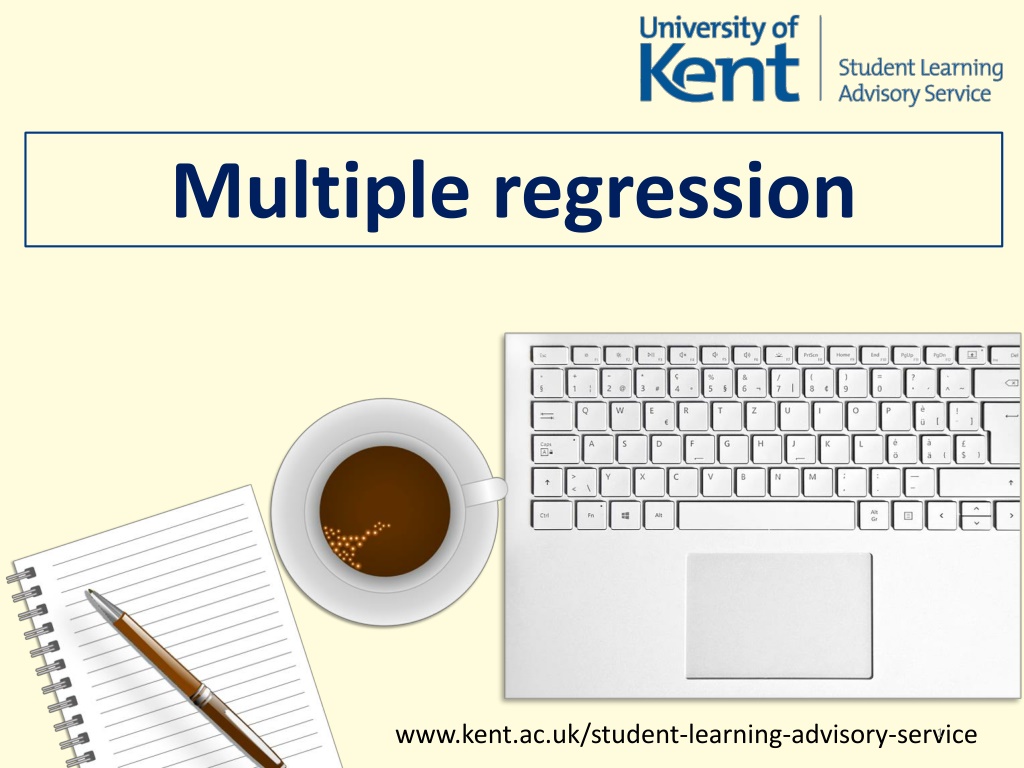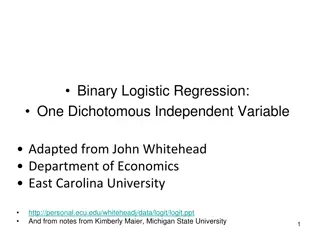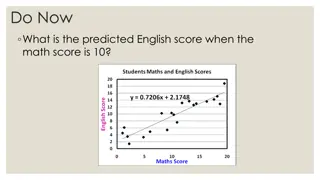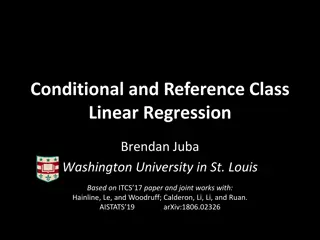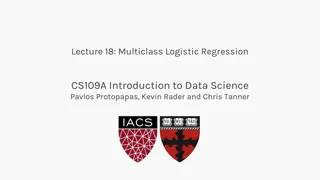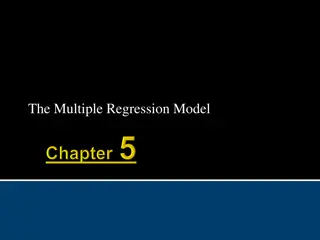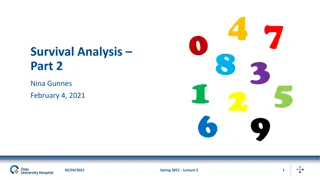Understanding Multiple Regression in Statistics
Introduction to multiple regression, including when to use it, how it extends simple linear regression, and practical applications. Explore the relationships between multiple independent variables and a dependent variable, with examples and motivations for using multiple regression models in data analysis.
Download Presentation

Please find below an Image/Link to download the presentation.
The content on the website is provided AS IS for your information and personal use only. It may not be sold, licensed, or shared on other websites without obtaining consent from the author. Download presentation by click this link. If you encounter any issues during the download, it is possible that the publisher has removed the file from their server.
E N D
Presentation Transcript
Multiple regression www.kent.ac.uk/student-learning-advisory-service 1
Multiple regression Introduction We will introduce multiple regression, in particular we will: Learn when we can use multiple regression Learn how multiple regression extends simple linear regression Learn how to use multiple regression in real applications This presentation is intended for students in initial stages of Statistics. No previous knowledge is required. It is advised to first read the presentation on simple linear regression. 2
Multiple regression Regression is used to study the relationship between one dependent variable and two or more independent variables. Just as in single regression, we need the dependent variable to be numerical. The independent variables can be numerical or categorical. However, if all the independent variables are categorical, it is best to use ANOVA. 3
Motivation Single regression (i.e., with one IV) allows us to study the relationship between two variables only. However, in reality, we do not believe that only a single variable explains all the variation of the dependent variable. For example, in the scenario of IQ and income, we do not expect IQ only to explain income, but we expect that there are also other variables, such as years of education, to explain income. Hence, to make the model more realistic, it makes sense to include multiple independent variables in the regression. 4
Examples Examples The following are situations where we can use multiple regression: Testing if IQ and level of education affect income (IQ and years of education are the IV and income is the DV). Testing if study time and pre-test scores affect final grades (DV is final grades, and study time and pre- test scores are the IV). Testing if exercise and amount of salt in the diet affect blood pressure (exercise and salt are the IV and blood pressure is the DV). 5
Displaying the data Displaying the data As opposed to the simple linear regression case, we do not have a way to plot all the variables at the same time. Hence, the scatterplot can be performed only for each continuous independent variable independently. 6
Multiple linear regression Multiple linear regression Example: Testing if study time and pre-test scores affect final grades (DV is final grades, and study time and pre-test scores are the IV). y = b0 + b1*X1+ b2*X2 + E b2 b1 final grade pre-test score 7 study time
Multiple linear regression Multiple linear regression y = b0 + b1*X1 + b2*X2 + ...... + bn * Xn + E b2 final grade b1 pre-test score study time 8
Assumptions of regression Assumptions of regression The errors E are normally distributed. This can be tested by plotting an histogram of the residuals of the regressionand checking that they all have a bell shape. Alternatively, you could use the Shapiro-Wilk test for normality. 9
Assumptions of regression Assumptions of regression There are no clear outliers This can be checked by performing the scatterplot. The outliers (circled in red in the figure) can simply be removed from the analysis . 10
Hypothesis testing Hypothesis testing Regression tests, for each variable ??, the null hypothesis: H0 : There is no effect of ?? on Y. versus the alternative hypothesis: H1 : There is an effect of ?? on Y. If the null hypothesis is rejected, there is an evidence that there is a significant relationship between ?? and Y. 11
Hypothesis testing Hypothesis testing We perform multiple regression in SPSS and look at the p-value of each coefficient ??. If the p-value is less than 0.05, we reject the null hypothesis, otherwise, we do not reject the null hypothesis. Hence, we just look at the p-value as in simple regression, but for each variable. 12
Regression in SPSS Regression in SPSS (from statistics.leard.com) Assume that you re trying to investigate the relationship between an individual s VO2 max and the individual s age, weight, heart rate and gender. In this case, VO2 max is the dependent variable and all the others are independent variables. 13
Regression Regression in SPSS in SPSS First, go on Analyze > Regression > Linear.. 14
Regression Regression in SPSS in SPSS In the Linear Regression box, transfer the DV (VO2max) to the Dependent box and the IV (age, weight, heart rate and gender) to the Independent(s): box 15
Regression Regression in SPSS in SPSS Click on Statistics and tick Estimates and Model fit , then click Continue . Finally, click on the OK Button 16
Regression Regression in SPSS in SPSS Look for the box Coefficients and identify the numbers under Sig. Those numbers are the p-value of each variable. If this number is less than 0.05, the respective variable is significant, otherwise it is not. In the example, all the variables are significant. 17
Regression Regression in SPSS in SPSS Similarly to simple regression, if the respective coefficient B is positive, the variable has a positive effect, otherwise it has a negative effect. In this case, age, weight and heart-rate all have a negative effect (that is, as they increase, VO2max decreases). Gender has a positive effect. To understand the meaning, we look at how gender was coded. Since gender was a coded as 0 for females and 1 for males and the effect of gender is positive, that means that being male increases the VO2max. 18
To book a maths/stats appointment To book a maths/stats appointment www.kent.ac.uk/student-learning-advisory-service 19
